The Juno probe has significantly redefined scientists' understanding of Jupiter.

by
Juno is NASA's Jupiter probe, launched in 2011 and placed into orbit around Jupiter in 2016 to begin observations. Originally scheduled to end in 2018, its operational lifespan has been repeatedly extended, and as of the time of writing, Juno continues to observe Jupiter. Juno has significantly redefined scientists' understanding of Jupiter, and the science magazine Scientific American has summarized the history of Juno's launch and its results.
How NASA's Juno Probe Changed Everything We Know about Jupiter | Scientific American
https://www.scientificamerican.com/article/how-nasas-juno-probe-changed-everything-we-know-about-jupiter/

The story behind the launch of the Juno spacecraft
Jupiter is the fifth gas giant planet orbiting the solar system from the inside, and is thought to be the first planet to form in the solar system. Scott Bolton, principal scientist for the Juno mission and a member of the Southwest Research Institute in the United States, said, 'That's why Juno was created: to probe Jupiter's interior in every way we know how, to understand what happened in the early solar system when Jupiter formed, and what role Jupiter played in the formation of planets like Earth.'
The name of the probe, 'Juno,' comes from Juno, the wife of Jupiter , the Roman god from whom the planet Jupiter is derived. According to myth, Jupiter would hide his misdeeds behind clouds so that no one could see them, but Juno had the ability to see through those clouds and keep an eye on Jupiter. In other words, Juno represents the desire to see through Jupiter's thick clouds and reveal what is inside.
The first detailed image of Jupiter was revealed to mankind in the late 1970s when the Voyager spacecraft took pictures of the planet . Bolton, who was a university student at the time, was fascinated by the photos of Jupiter taken by Voyager 1 when a NASA official from the Jet Propulsion Laboratory gave a lecture at his university.
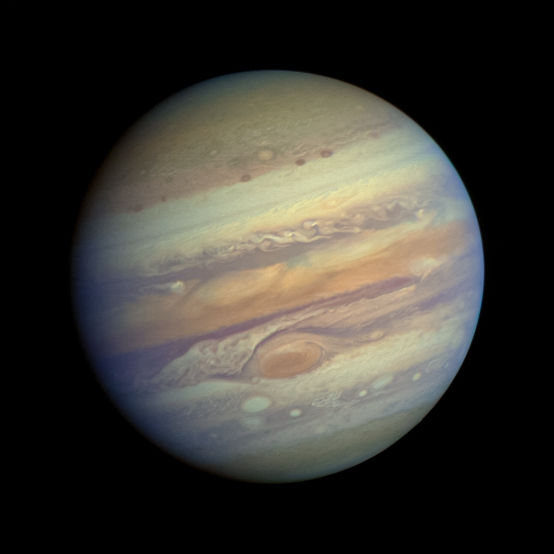
by
Bolton went on to work at the Jet Propulsion Laboratory, where he later worked on the Galileo mission, which investigated Jupiter's atmosphere and magnetic field. Galileo orbited Jupiter from 1995 to 2003, but many mysteries remained, such as the nature of Jupiter's core and storms. So, at the start of the 21st century, Bolton and his team began developing Juno, investing $1.1 billion (approximately 160 billion yen).
Challenges Juno faced
Juno was originally planned not to have a visible-light camera because even a slight increase in weight would have a significant impact on the spacecraft. While a visible-light camera wasn't necessary for the spacecraft's scientific objectives, Bolton insisted, 'We can't go to Jupiter without a camera,' and ultimately a visible-light camera called JunoCam was installed.
The biggest challenge Juno's mission designers faced was how to shield the probe from the radiation around Jupiter, which severely degrades all electronic equipment. To protect against radiation, Juno orbits Jupiter above its poles, where radiation levels are lowest, allowing for limited observation time, and storing its most important electronic equipment in a titanium vault.
The diagram below shows Juno's orbit around Jupiter. It shows how it is observing Jupiter in a very large orbit. The equipment inside the titanium storage facility is exposed to only 800 times less radiation than the spacecraft itself.
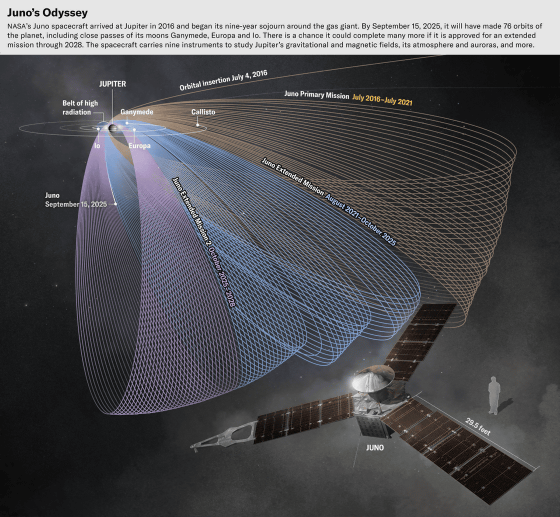
by Matthew Twombly
Juno takes photos of Jupiter
The Juno mission team hopes these strategies will allow the probe to survive for at least a year, but they won't know for sure until it orbits Jupiter's polar orbit. In the end, Juno successfully completed its polar orbit around Jupiter, and despite the disadvantage of its increased weight, its onboard JunoCam was able to take beautiful photos of Jupiter.
The image below, taken by Juno, shows Jupiter's surface covered in strange swirls and undulations, as well as the existence of giant cyclones encircling its poles. 'It's like a work of art,' Bolton said.
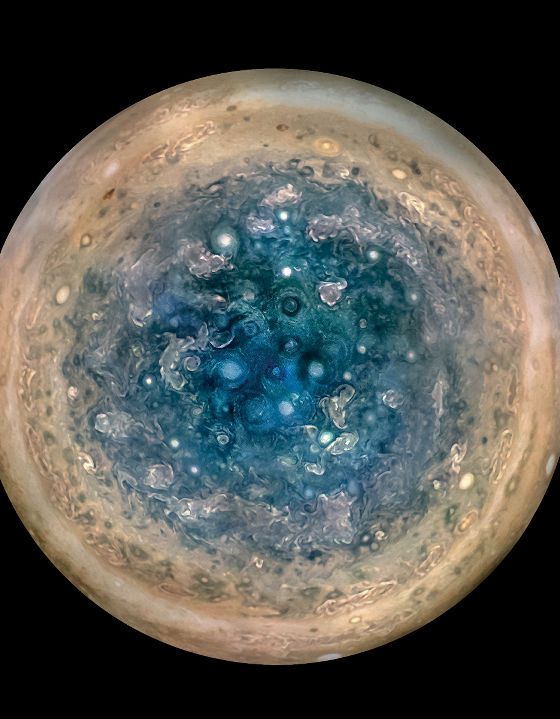
by NASA's Marshall Space Flight Center
The images taken by JunoCam on board Juno are available on the official NASA website below.
JunoCam Images - NASA Science
https://science.nasa.gov/gallery/junocam-images/
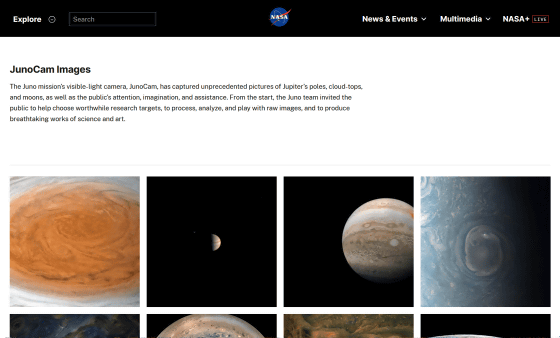
Jupiter's lightning is different from that of Earth
Jupiter is constantly plagued by storms, and lightning is common, but the lightning observed by Juno was a type of lightning that doesn't exist on Earth. Normally, lightning occurs when liquid water collides with ice crystals, but the altitude at which Juno observed the lightning was so cold that only ice crystals can exist.
After observing Jupiter's giant clouds for some time, the Juno team finally determined that the cause was the 'large amount of ammonia contained in Jupiter's clouds.' Ice blown into the sky by storms combines with ammonia, which acts like antifreeze, keeping ammonia water in liquid form even at altitudes where it would normally freeze. When this liquid strikes the rising ice crystals, electricity is generated, causing lightning at altitudes that would not normally be possible.
Juno's microwave radiometer also showed that ammonia was disappearing from parts of Jupiter's uppermost atmosphere, apparently because ammonia at high altitudes was liquefying water, forming 'softball-sized chunks of liquid ice,' which then fell deeper into Jupiter and melted.
'Shallow Lightning' and 'Mushballs' Reveal Ammonia to NASA's Juno Scientists - NASA
https://www.nasa.gov/centers-and-facilities/jpl/shallow-lightning-and-mushballs-reveal-ammonia-to-nasas-juno-scientists/

The Mystery of Jupiter's Core
One of the mysteries surrounding Jupiter was what its innermost core is made of. Before Juno's observations, the two most likely theories were that it had a rocky and metallic core similar to that of other planets, or that it had no core at all, just a sphere of super-compressed gas at its center.
However, scientists discovered that Jupiter actually had a solid core at its innermost layer, but that it was gradually dissolving into the surrounding layers. This was a very different environment from Earth, where there is a definite boundary between the core and the surrounding mantle, and it puzzled scientists.
Additionally, Jupiter, being a giant planet, likely swallowed rocky and planet-sized debris during its formation, contains far more heavy elements than the Sun. However, while these elements appear to be present in the upper atmosphere, they are relatively scarce in the innermost core, contradicting the common belief that heavy elements should sink to the core due to gravity.
Discoveries about Jupiter's moon Io
Juno has observed Jupiter itself as well as its moons, revealing the chemical composition of two moons: Ganymede , the largest in the solar system, and Europa, which has an internal ocean. However, the most shocking discovery was the discovery of Io , a moon with many active volcanoes.
Since the 1970s, scientists have understood that Io's volcanic activity is driven by its elliptical orbit around Jupiter. When Io is closer to Jupiter, its gravitational influence on the planet is greater, and when it is farther away, its influence is weaker. This retaliatory movement creates large tidal forces on Io, which creates a lot of friction and produces a lot of magma.
Many scientists have long believed that Io has a continuous magma ocean beneath its surface. However, when Juno approached within 1,450 km of Io's surface, it found no sign of a magma ocean . Instead, it showed that each volcanic eruption is driven by a separate magma chamber.
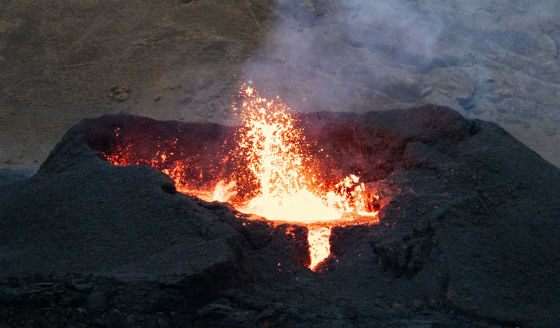
◆The future of Juno
Judging by various information, the radiation should have destroyed Juno's main body or at least some of its instruments, but somehow Juno continues to observe as of the time of writing. The extended mission period ends in September 2025, but if a mission extension is approved for another three years, it is expected that it will be able to better observe less well-known areas of Jupiter.
'However, the probe's accomplishments are already clear. Juno has revealed Jupiter to be a more mysterious place than anyone could have imagined, and it has forced scientists to discard outdated ideas about planet formation. It has also revealed how future space missions can protect themselves from the solar system's worst radiation,' Scientific American said.
Related Posts:
in Science, Posted by log1h_ik







